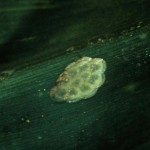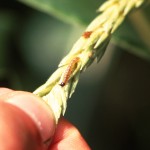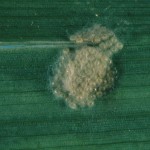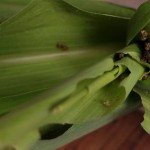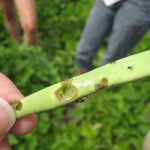Thirty-three sites reported this week. Seven of the sites had European corn borer (ECB)-E and seven sites had ECB-Z. Twenty sites reported corn earworm (CEW) with eighteen enough to be on a 4, 5 or 6 day spray interval (see table at bottom of post). Fall armyworm (FAW) was caught at eighteen sites and Western bean cutworm (WBC) was caught at seventeen sites. The hybrid ECB moth was not caught at any of the six reporting sites.
Often at this time of year we are catching CEW at most locations and in high enough numbers that other moths will be controlled by the spray timing needed for CEW. In the absence of CEW, continue to scout for ECB egg masses, and ECB and FAW larvae and feeding damage, using a threshold of 15% infested plants in tassel emergence stage fields and 5% in silk stage fields.
- ECB egg mass
- ECB feeding damage on leaves.
- ECB larva in tassel
- Fall armyworm egg mass.
- Fall armyworm feeding damage and frass.
- Fall armyworm larva, note the inverted ‘Y’ om head capsule.
| Location | ECB-E | ECB-Z | Hybrid | CEW | FAW | WBC | DD | |
| Western NY trap Catch |
||||||||
| Attica (Wyoming Co.) | 0 | 0 | 0 | 0 | 0 | 1 | 2036 | |
| Baldwinsville (Onondaga Co.) | 1 | 2 | NA | 0 | 0 | 0 | 2169 | |
| Batavia (Genesee Co.) | 0 | 0 | NA | 0 | 0 | 4 | 2095 | |
| Bellona (Yates Co.)* | 0 | 0 | 0 | 0 | 19 | 0 | 2142 | |
| Brockport (Monroe Co.) | 0 | 0 | NA | 0 | 0 | 0 | 2090 | |
| Eden (Erie Co.) | 0 | 0 | NA | 7 | 26 | 1 | 2098 | |
| Farmington (Ontario Co)* | 0 | 0 | 0 | 0 | 0 | 0 | 2198 | |
| Geneva (Ontario Co.)* | 3 | 1 | 0 | 22 | 11 | 0 | 2145 | |
| Hamlin (Orleans Co.) | 3 | 0 | NA | 6 | 2 | 14 | 2109 | |
| Kennedy (Chautauqua Co.) | NA | NA | NA | NA | NA | NA | 1970 | |
| King Ferry (Cayuga Co.) | 0 | 0 | NA | 12 | 47 | 0 | 2052 | |
| Kirkville (Madison Co.) | 0 | 0 | NA | 2 | 0 | 0 | 2121 | |
| LeRoy (Genesee Co.) | 1 | 1 | NA | 2 | 5 | 1 | 2092 | |
| Lyndonville (Orleans Co.) | 0 | 0 | NA | 6 | 1 | 6 | 2050 | |
| Oswego (Oswego Co.) | 0 | 0 | NA | 0 | 0 | 1 | 1972 | |
| Panama (Chautauqua Co.) | 0 | 1 | NA | 3 | 2 | 0 | 1830 | |
| Penn Yan (Yates Co.)* | 0 | 2 | 0 | 4 | 0 | 0 | 2073 | |
| Portville (Cattaraugus Co.) | 1 | 4 | NA | 2 | 0 | 8 | 1817 | |
| Preble (Cortland Co.) | NA | NA | NA | NA | NA | NA | 1821 | |
| Ransomville (Niagara Co.) | 0 | 0 | NA | 0 | 1 | 1 | 2162 | |
| Seneca Castle (Ontario Co.)* | 0 | 0 | 0 | 0 | 2 | 0 | 2103 | |
| Sherwood (Cayuga Co.) | NA | NA | NA | NA | NA | NA | 2085 | |
| Williamson (Wayne Co.) | NA | NA | NA | NA | NA | NA | 1996 | |
| Eastern NY trap Catch |
||||||||
| Amsterdam (Fulton Co.) | NA | NA | NA | NA | NA | NA | 2051 | |
| Feura Bush (Albany Co.) | 0 | 0 | NA | 12 | 1 | 1 | 2239 | |
| Florida (Orange Co.) | 0 | 0 | NA | 4 | 86 | 2 | 2319 | |
| Greenwich (Washington Co.) | 0 | 0 | NA | 10 | 36 | 2 | 2193 | |
| Hurley (Ulster Co.)* | 0 | 0 | 0 | 74 | 0 | 1 | 2241 | |
| Kinderhook (Columbia Co.) | 0 | 0 | NA | 29 | 25 | 0 | 2253 | |
| Melrose (Rensselear Co.) | 0 | 0 | NA | 1 | 0 | 0 | 2208 | |
| Middleburgh (Schoharie Co.) | NA | NA | NA | NA | NA | NA | 2245 | |
| New Paltz (Ulster Co.) | 0 | 0 | NA | NA | NA | 0 | 2346 | |
| Peru (Clinton Co.) | 3 | 0 | NA | 0 | 19 | 4 | 2077 | |
| Plattsburgh (Clinton Co.) | 9 | 0 | NA | 1 | 3 | 27 | 2113 | |
| Plessis (Jefferson Co.) | 0 | 1 | NA | 0 | 1 | 5 | 2172 | |
| South Colton (St. Lawrence Co.) | NA | NA | NA | NA | NA | NA | 1885 | |
| Stone Ridge (Ulster Co.) | 0 | 0 | NA | 12 | NA | NA | 2206 | |
| Ticonderoga (Essex Co.) | 0 | 0 | NA | 0 | 0 | 1 | 2148 | |
| Tivoli (Dutchess Co.) | 0 | 0 | NA | 22 | NA | NA | 2325 | |
| Unadilla (Delaware Co.) | 0 | 0 | NA | 10 | 3 | 0 | 1899 | |
| ECB – European Corn Borer CEW – Corn Earworm FAW – Fall Armyworm WBC – Western Bean Cutworm NA – not available DD – Degree Day (base 86/50) April 1st accumulation Climate Smart Farming |
||||||||
| trap catches for the week of 8.18.20 – 8.25.20 |
||||||||
Dry Bean Western Bean Cutworm Alert
8.25.20
Marion Zuefle, NYS IPM Program and Margie Lund, CVP
(Information and photos from T. Baute, OMAFRA)
This year we are monitoring eight WBC traps placed next to dry bean fields. Dry bean growers should scout adjacent corn for WBC eggs and larvae when cumulative trap catch reaches 50 moths or 7-10 days after peak emergence, and should continue to scout for three weeks, especially if damage has been seen in recent years. Peak flight occurred the first week of August. Dry bean pod scouting should begin 7-10 days after peak emergence (given in blue below), in those fields which have accumulated over 50 moths/trap, near fields with high trap counts, or where WBC has been found in bean pods/seeds in recent years.
| Dry Bean Location | 7.21.20 | 7.28.20 | 8.4.20 | 8.11.20 | 8.18.20 | 8.25.20 | Cumulative WBC |
| Avoca Hill (Steuben Co.) | 23 | 67 | 80 | 21 | 3 | 2 | 196 |
| Avoca Valley (Steuben Co.) | 6 | 44 | 94 | 43 | 8 | 0 | 196 |
| Caledonia South (Livingston Co.) | 6 | 54 | 58 | 32 | 22 | 2 | 174 |
| Caledonia Southwest (Livingston Co.) | 8 | 100 | 101 | 48 | 21 | 4 | 282 |
| Geneva (Ontario Co.) | 13 | 38 | 42 | 52 | 11 | 1 | 159 |
| Riga (Monroe Co.) | 24 | 49 | 28 | 17 | 10 | 3 | 132 |
| Stafford (Genesee Co.) | 18 | 41 | 34 | 5 | 1 | 1 | 102 |
| Wayland (Steuben Co.) | 4 | 24 | 92 | 38 | 16 | 0 | 176 |
| Western Bean Cutworm trap counts by date. | |||||||
WBC eggs, laid shortly after moth emergence, take 5-7 days to hatch. Pod feeding typically begins 10 days after peak moth catch. Early feeding by small larvae is generally minor and does not go into the pod. Growers in areas of concern should scout bean pin pods and larger pods for damage/feeding holes. Check 10 spots in a field, 5 plants per spot. WBC larvae hide in the soil during the day and won’t be seen on beans. If you find larvae in the pods during the day they are most likely European corn borer.
- Early damage made by small WBC larvae.
- Damage caused by slug feeding, note slime trail.
- Later feeding damage going through pod and into beans.
- Later feeding damage on beans.
- ECB larva in bean pod.
This project is funded by the NYS Dry Bean Industry.

